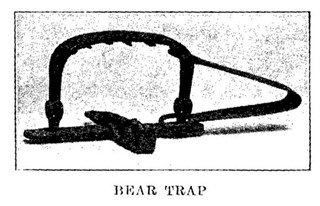The black timber wolf was not so common as the gray wolf of the prairies, but he was just as destructive. When very hungry in the cold days of winter these animals would come so close to the settler�s cabin that they could be shot. The prairie wolf and his dismal howling during the night is well known to many now living in Iowa. Occasionally a black wolf is caught and the gray ones are quite frequently captured. But they do not go in packs any longer, nor come so close to houses as in that early day when they were dangerous enemies.
In recent years a reward has been paid to any one who killed an old wolf or captured a young one. Sometimes baby wolves are dug out of their dens in the ground and they have often been kept as pets. But their wolfish nature is sure to show and they do not make pleasant playfellows. The hound, it is said, is the only dog that would capture a wolf, for the common cur would follow the animal only so long as he kept running. When the wolf stopped the dog would stop and refuse to fight. Indeed, such cowardly dogs have often joined in play with the wolf as two puppies would play. But the faithful hound never failed to bring the wolf to bay; nor did he stop to play with his enemy.




